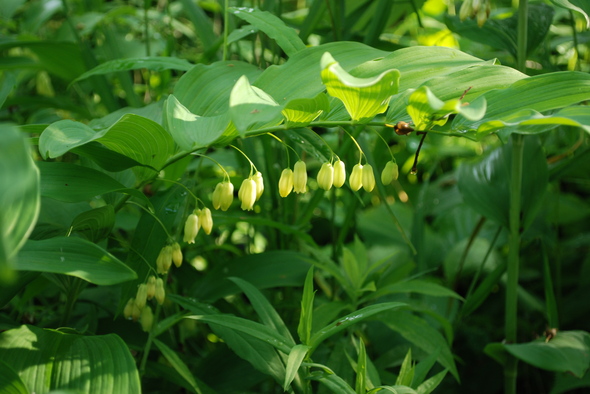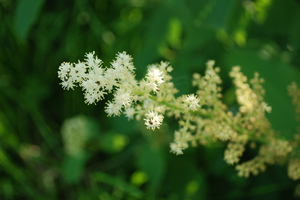Solomon's Seal: A native plant and its look-alike impostors

The tubular flowers of Solomon's Seal (Polygonatum biflorum) hang below its arching stem.
Rick Meader | Contributor
Right now, growing in a woods near you, is a native wildflower, not terribly showy, but interesting to say the least. And, also growing in what may the same woods is an imposter, trying to look like the first, but whose showy flower gives it away. Both have poise, both have allure, but one is a fake!
I’m talking, of course, about Solomon’s Seal (Polygonatum biflorum) and False Solomon’s Seal (Smilacina racemosa). Let’s learn about these two members of the Lily family.
First, the true Solomon’s Seal. This plant gets its common name from the roots, whose leaf scars resemble, to some, the seal of King Solomon. Check photos of each out on the web and see what you think. I don’t see it, but I don’t see constellations well, either.
The plant itself is coming up now, sometimes in small, fairly dense patches within woods and thickets. It has a single, arching stem that may reach to between one and three feet in height. (In my yard, it usually reaches the higher end of that range).
The leaves have noticeable parallel veins, are arranged alternately along the stem and reach between three and six inches long and one and a half to two inches wide.
The true defining characteristic of the plant is its flowers. They are greenish-white tubular flowers about half- to three-quarters-inch long and arranged in pairs, dangling from the stem. They are forming now and grow with the plant as it emerges from the ground.
Eventually, the flowers form into blue-black berries, about three-eighths of an inch in diameter that last into the winter. It’s a pretty interesting looking plant. The U.S. Department of Agriculture site has a lot of good information about it, and another site, HerbCraft.org, discusses its use as an herb.

The showy flower of the imposter, False Solomon's Seal (Smilacina racemosa).
Rick Meader | Contributor
Now, for the imposter. False Solomon’s Seal gets its name because it looks like Solomon’s Seal in terms of its plant structure, which is an arching, single stem, with alternate leaves that reach about three to six inches long. But, in terms of the flower, the imposter outshines the “original”.
False Solomon’s Seal (and its close cousin, Starry False Solomon’s Seal - Smilacina stellata), have a plume/raceme of white flowers at the end of the stalk that eventually become reddish brown berries.
It is native to the entire North American continent. If you want a showy flower in your yard in the spring that keeps its interest with its berries and you have light shade to full sun, this is a great native plant for you.
I have both in my yard, and can tell you that I like both, but I like the imposter more. Birds also like it for its berries. Here are a couple of sites with more information about it:
http://www.amandagarden.com/Falsesol.html
http://plants.usda.gov/java/profile?symbol=MARAR&mapType=nativity&photoID=marar_001_avp.tif.
Both of these plants are commercially available from native plant nurseries.
Unrelated to the above, but something that I wanted to pass along, is the fun that spring brings in terms of color, unrelated to flowers (the earliest of which seem to be mostly white, or light shades of pink and blue). It’s almost like a reverse fall.
Cherry leaves have a reddish brown cast before they turn green. Oaks and maples have an ephemeral yellow-green color that only comes in spring. Many early wildflowers, including- bloodroots, wild geranium, jack-in-the-pulpits and carrion flowers all have a reddish hue that is lost as the plants mature. You have to get out in the woods early in the year to enjoy this subtle splendor, but it’s worth it.
Well, our little yard is a-blooming. Among the plants in flower are Trillium, Rue anemone, Graceful sedge, Wild strawberry, Pussytoes, Golden Alexander, Violets, Virginia bluebells, Early meadow rue, Foamflower, Jack-in-the-pulpit, Spring Beauty, Bellflower and Wild ginger. Hepatica and Dutchman’s Breeches have said goodbye until next year.
Ferns, and a ton of other later-blooming wildflowers are emerging, and Woodland Sunflower is again trying to take over my small prairie. Not all native plants are welcome in certain situations, and if your space is limited, I don’t recommend it unless you want a mass of the admittedly pretty late summer bloomer taking over the space, given the right conditions, which I apparently have.
The spring ephemerals don’t last long, so get out early and often to a woods near you to enjoy the wonder they provide.
Rick is a local landscape architect with a special interest in all things natural, including native plants and the critters that eat them. You can contact him at yourland1824@gmail.com.


Comments
EcoRonE
Wed, May 11, 2011 : 12:08 p.m.
Thanks Rick for promoting our native flora. I performed a rescue some years ago and created a 'woodland' bed under the shade of the city's Norway maple on my lawn extension. Unfortunately, the trillium and jack-in-the-pulpit disappeared after a few years. The false solomon's seal hasn't thrived there. The may apples keep coming up but not like in the wild. The plant that really thrives in the area is the bits of Pennsylvania sedge that got carried along with the other more prized natives. Some large meadow rue volunteered in the area and is quite robust under the maple. Regarding color, I love the myriad shades of green textures that carpet the forest floor in spring.